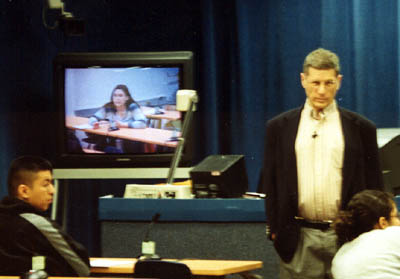Merits of web and TV classes stir debate

Image: Merits of web and TV classes stir debate :Professor Robert Friedman lectures to his government class in a campus studio and via television. Opinions differ on whether distance learning classes like this one help or hurt students.Photo by Yvonne Garcia/State Hornet:
April 2, 2002
Faculty are divided over whether distance education courses are as beneficial to students as those taught in a traditional classroom environment, even as Sacramento State searches for ways to accommodate a growing student population.
Distance learning connects the teacher and student via computer, television, telephone and cable networking to create a virtual classroom.
Some faculty say it is a style of instruction that detracts from the institutional-centered model of classrooms and lacks the necessary interaction between students, their peers and faculty.
“The school has a lack of student involvement anyway,” Professor of Operations and Strategic Management Herb Blake said. “By promoting these classes, we?re encouraging them to be even less involved with campus life.”
Other faculty disagree, arguing that students are anything but disconnected.
“I have great participation with my students,” Management of Learning and Teaching Professor Paula Gardner said. “I don?t think you can really take a distance learning class and not be connected,” she said. “They require a certain amount of discipline.”
The average distance learning class size ranges anywhere from 25 to 65 students, depending on the individual course and demand for it from other colleges.
Faculty said they generally have more students learning from a distance, but often have students switch to the classroom setting or vice versa, if they find one style suits them better than the other.
All distance education courses are recorded, so if students miss a class for any reason, they can go to the library and review a copy of the lecture if they didn?t tape it at home.
Professor of Accountancy Merle Martin has taught distance learning courses for more than six years and recently integrated a “case study” approach with his class.
He calls on students both in and outside of the classroom, telling them to be prepared to lead a discussion about the lecture given that day for the following class meeting.
“I?ve had positive feedback with it,” Martin said.
Timid students are a challenge for distance education teachers.
“I make it a requirement that my students send me a picture of themselves,” Gardner said. “That way, everyone in the class can put a face with a name instead of just hearing them over a microphone.”
One of the most challenging aspects of distance learning is findingfaculty who feel comfortable integrating technology into their curriculum.
“Some faculty feel unbelievably threatened by it,” Assistant Director of Media Technologies Allan Hinderstein said. “But more and more, I think instructors are realizing it?s an incredible way to communicate with the public and show them what their course has to offer.”
Supporters of distance education say the shift in teaching styles promotes a more active learning community.
“This technology allows us to reach a number of different audiences,” Hinderstien said.
Many of the distance learning classes can be viewed on cable channel 71 or 72.
Critics of distance education agree that the courses reaches students in remote areas, but they don?t think distance learning should become mainstream.
“The more options we give students not to come to class just contributes to less interaction,” Blake said. “They won?t become a part of the institution being that isolated.”
Blake said that while students in Sacramento may want more distance learning courses available to them, the demand for the courses in other cities and colleges is not great enough to warrant the development of more classes.
“If other colleges were to contact us and express a demand for certain classes, then it might be time to reconsider,” he said. “But right now that demand doesn?t exist.”
Supporters argue that there is a demand.
“For those students who have full time jobs and families, a regular school schedule just isn?t possible,” Gardner said.
Send comments, questions, or concerns to [email protected]
For questions or information regarding thesite, please contact [email protected]




































































































































